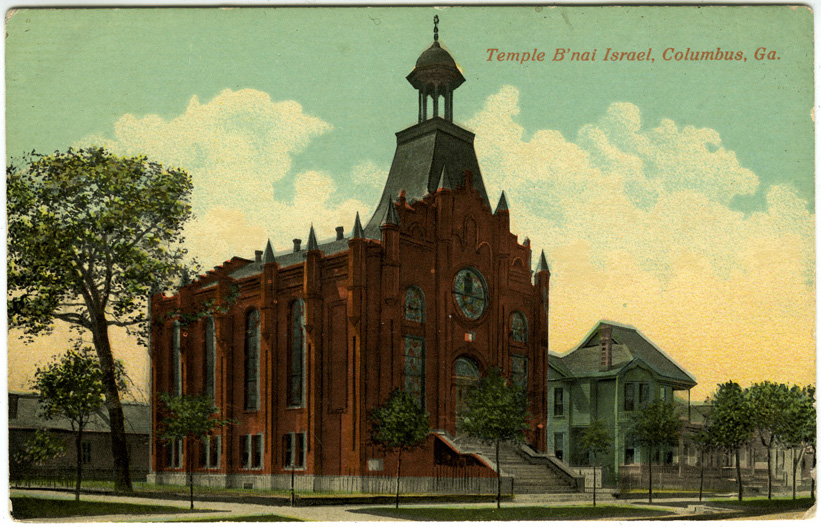2.5 Columbus, Georgia
B’nai Israel, 10th Street and 4th Avenue
Architect unknown, 1887
Publisher and publication date unknown
In 1885, the Daughters of Israel, the Ladies organization of Temple B’nai Israel (Sons of Israel), passed a resolution calling on the congregation to build a proper synagogue for its members. The congregation, the second oldest in Georgia, had outgrown the house purchased in 1859 and used as a meeting place. In November 1886, members broke ground on a new building after moving the house to the lot next door. When the synagogue was dedicated in September 1887, the local newspaper called it “one of the most beautiful buildings in the city. It would be an ornament to a city thrice the size of Columbus.”1
The design has been called “Byzantine” and “Oriental.” In fact, it is a variant of the popular Romanesque and Gothic styles used for many southern churches. Only the tower is peculiar. It is a central facade tower, like many found in synagogues, but it combines an unusual mansard roof topped by columns rising to an open gazebo surmounted by a small cupola.
A large crowd, including many non-Jews, attended the dedication. Christian ministers were in the audience as Rabbi S. Hecht from Montgomery gave the keynote address that punctuated the three-hour service. The congregation held a banquet at which Columbus Mayor C. B. Grimes was an honored guest. Congregation president Leopold Lowenherz thanked the Christians of Columbus for helping to build the synagogue. He called it a “monument” to their “liberal sentiment, culture, generosity, and good feeling.” The editor of the Columbus Daily Enquirer had a great time at the festivity, commenting, “At a Jewish banquet they certainly know how to ‘set up’ the wine. Did you ever attend a Jewish celebration that you did not have the best time you ever had?”2
The congregation remained in the 1880s building until the 1950s, but the interior of the temple was destroyed in a fire in 1907, along with historical records. When the temple was rebuilt, the interior was remodeled, and the choir loft and organ were moved.
In the 1950s, the Jewish Ladies Aid Society again took the initiative. They called for the construction of a new synagogue in 1952, which led in 1956 to the congregation acquiring a site on Wildwood Avenue. The old building was sold. It was demolished in 1958 when the congregation moved into its new home with a new name, Temple Israel. Built in a modern style, it was designed by architects Braverman and Halperin of Cleveland, Ohio.
1 Unidentified, quoted in “Encyclopedia of Southern Jewish Communities – Columbus, Georgia,” Goldring/Woldenberg Institute of Southern Jewish Life, http://www.isjl.org/georgia-columbus-encyclopedia.html.
2 Quoted in “Encyclopedia of Southern Jewish Communities – Columbus, Georgia,” Goldring/Woldenberg Institute of Southern Jewish Life, http://www.isjl.org/georgia-columbus-encyclopedia.html.
